Chinese-owned Vessel Likely Responsible for Damage for Pipeline and Cables in Baltics
The October 8th incident illustrates China's willingness to expand its use of gray zone tactics to other regions to show its disapproval of countries going against its core interests.

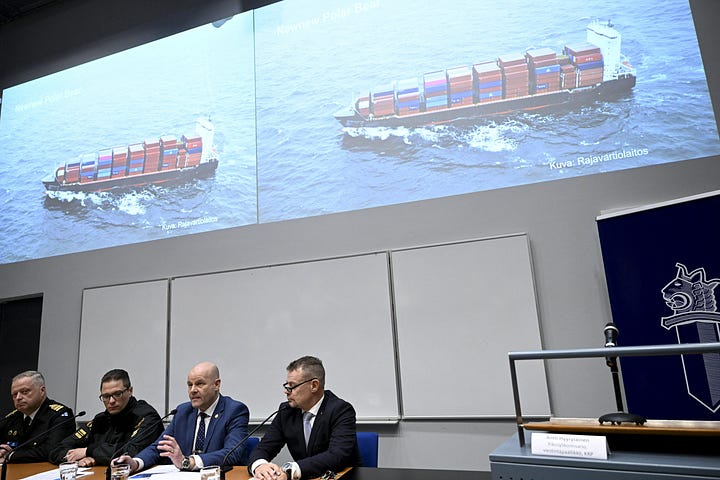
On October 8th, Finnish officials reported the undersea Balticconnector natural gas pipeline and a telecommunications cable connecting Finland and Estonia received damage by external activity.
On October 8th, Finnish officials reported the undersea Balticconnector natural gas pipeline and a telecommunications cable connecting Finland and Estonia received damage by external activity. Swedish and Russian officials also reported that two telecommunications cables were damaged on the same day. Originally, investigators suspected that Russia damaged the cables and pipeline to show its disapproval of Finland joining NATO. However, an investigation indicated that the Chinese-owned/Hong Kong-flagged cargo vessel, NewNew Polar Bear, intentionally damaged the cables and pipeline. While investigators did not say why the cargo ship deliberately damaged the cables and pipeline, China likely damaged them to coerce Estonia to stop increasing its ties with Taiwan.

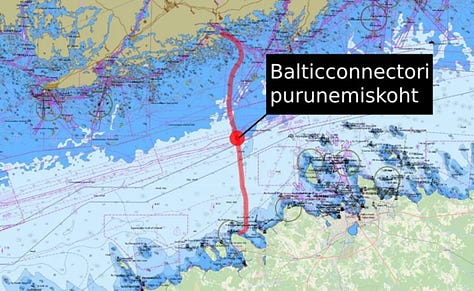
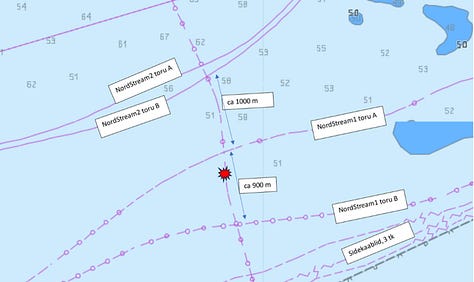
October 8th Incident and Investigation
On October 8th, Finnish officials reported that the undersea Balticconnector natural gas pipeline and the Elisa telecommunications cable connecting Finland and Estonia received damage from external damage. Both Finnish and Estonian gas operators shut down gas flow through the pipeline due to the amount of damage the line sustained. Finnish officials confirmed that the pipe damage and leak occurred within their Exclusive Economic Zone (EEZ) while Estonian authorities said the cable damage occurred in their EEZ. Swedish officials also said in the days after the incident that the EE-S1 fiber optic cable connecting Sweden and Estonia was also damaged. The Russian company Rostelecom also said in early November that Baltika, one of their armored fiber optic cables from Russia to Kaliningrad also received some damage. However, the company said that users in the area were not affected due to the data transmitted via terrestrial lines and satellite channels. Finnish authorities said repairs to fix the pipeline’s damage are expected to last until April 2024 and to increase the pipeline’s capacity during the repairs. However, authorities from Estonia, Finland, and Sweden said that both Elisa and EE-S1 cable lines were repaired after a few days.




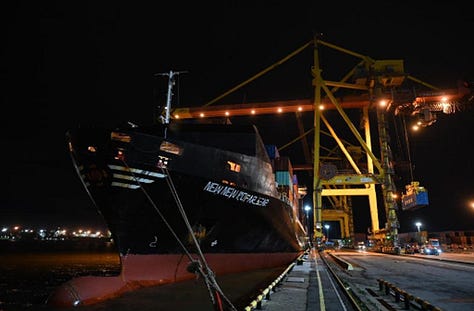




Estonia and Finland launched an investigation into the damage, with Finnish authorities examining the area surrounding the damaged pipeline. Finnish divers discovered a broken anchor with board drag marks leading up to it with a narrower path leading away from the anchor for several miles. Finnish officials believe the anchor caused the damage to the cables and pipelines due to traces of the pipeline’s paint found on the anchor. Authorities narrowed its investigation to the Chinese-owned/Hong Kong-flagged cargo vessel, NewNew Polar Bear deliberately damaging the infrastructure for several reasons. Several pictures show the vessel docked at St. Petersburg, Russia without its left anchor on the same day as Finnish officials discovered the damaged pipeline. Other pictures also show the vessel missing one anchor as it sailed into the port of Arkhangelsk on October 22.
Investigators also determined through Automatic Identification System (AIS) data that the ship was near all four locations when the damage occurred. Specifically, the data showed that the vessel passed over the EE-S1 cable at 4:13pm, the Baltika cable at 9:20pm, the Balticconnector at 11:20pm, and the Elisa cable at 12:49am local time. Furthermore, AIS data also showed that the ship stopped approximately 1.4 nautical miles (2.6 km) from the Balticconnector before sailing over the pipeline approximately eight minutes later. However, the Bear was also accompanied by the Russia-flagged Sevmorput which sailed with it to all three sites at the times the damages occurred. The vessel’s captain also did not answer any calls from either Estonian or Finnish authorities in the days after the incident. The vessel continued to China where Finnish and Estonian authorities asked Chinese officials to allow investigators to search the vessel and question the crew about the incident. Specifically, the investigators want to question the captain and crew about the vessel dragging the anchor for over 98 nautical miles (180 km).





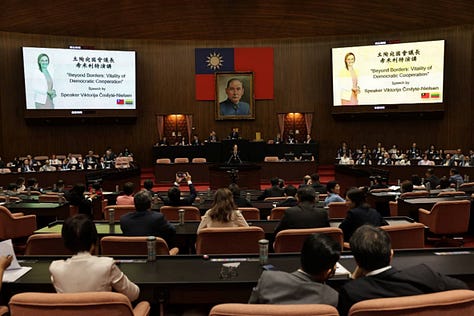



Increased Relations Between Taiwan and Baltic States
Beginning in 2021, the Baltic states and Estonia, Latvia, and Lithuania decreased their relations with China through various means such as withdrawing from the 17+1 Forum. The states also pass laws prohibiting Chinese company Huawei’s participation in its 5G network and to openly call for Taiwan’s participation in international organizations such as the World Health Organization. Senior Estonian and Lithuanian officials also made several visits to Taiwan and met several senior officials such as President Tsai Ing-wen and Vice President William Lai. Both countries also allowed senior Taiwanese officials to visit the countries and meet with businesspeople, universities, and think tanks. Estonia and Lithuania also allowed Taiwan to open representative offices in their countries. Lithuania allowed Taiwan to use ‘Taiwanese’ in the name instead of ‘Taipei’ when it opened the office in November 2021. Estonia also allowed Taiwan to open a representative office in November 2023 but under the name ‘Chinese Taipei Representative Office.’ China reacted negatively to both Estonia’s and Lithuania’s permitting Taiwan to open representative offices in their respective countries.
China’s Reaction
Lithuania
China reacted to Lithuania allowing Taiwan to open an office called ‘Taiwanese Representative Office’ through economic and diplomatic means. In November 2021, China immediately downgraded diplomatic relations with Lithuania from ambassador to chargé d’affaires and renamed its embassy to the Office of the Chargé d’Affaires. They also asked Lithuanian to do the same regarding their diplomatic mission in China. However, China then revoked Lithuania’s diplomatic status in December 2021 that resulted in Lithuania closing its embassy and abruptly leaving the country. China then imposed informal trade sanctions on almost all Lithuanian exports, with approximately 90 percent of goods prevented from entering the country’s market. China also imposed secondary trade sanctions that also affected the exports of other European companies if they contained Lithuanian-made components. Imports of Chinese products such as machinery and parts and the export of Lithuanian products to China completely halted. China continues to stop almost all Lithuanian goods at the border, with the country only allowing a small part of the imports to enter such as copper. Importers are still required to pay full payments up-front to import Chinese goods instead of the 15 to 20 percent prepayment before relations declined. However, Lithuania’s economy largely weathered the China’s trade sanctions since exports to China accounted for less than one percent of Lithuania’s total exports.
Estonia
China’s reaction to Estonia allowing Taiwan to open a representative office in the country was extremely limited compared to its reaction to Lithuania, consisting of only diplomatic threats. China’s ambassador Guo Xiaomei 郭晓梅 threatened to leave the country if Estonia allowed Taiwan to open an officer under the name ‘Taipei.’ China’s Foreign Affairs Ministry spokesperson Wang Wenbin 汪文斌 said that the country urged Estonia to abide by its commitment to the One China Principle and refrain from permitting Taiwan to open any official organization. However, reports indicate that Estonia and Taiwan are still in talks to formally open the office in the country.
Analysis: The evidence points to the NewNew Polar Bear dragging its anchor and damaging the Balticconnector pipeline and the three fiber optic cables. For example, the vessel was over the sections of the pipeline and cables when the damage occurred. The Russian company said they (allegedly) detected damage to the Baltika cable at around 9:30pm local time. Another piece of evidence is the multiple pictures of the Bear missing its anchor shortly after the incident occurred. Cargo vessels usually carry two or more anchors to increase their holding power and stability by using techniques such as tandem anchoring. However, one interesting point of the incident is how the anchor missed both NordStream 1A and 1B while damaging the cables and pipeline used by Estonia. It is likely the Chinese ship was assisted by the Sevmorput that sailed near it during the incident since the vessel could guide the Bear to the areas where the infrastructure was located at.
The incident also shows China’s willingness to expand its gray zone tactics to other countries outside the Indo-Pacific that goes against the country’s ‘core interests.’ Estonia allowing Taiwan to open a representative office would be considered by China as the country going against the ‘core interests’ of state sovereignty, territorial integrity, and national reunification. However, China realized that it could not implement the same coercive strategy with Estonia it did with Lithuania in 2021 because they proved to be ineffective. For example, China’s informal trade restrictions on nearly all of Lithuania’s exports in 2021 had only a marginal effect on the country’s economy since these exports only represented one percent. Furthermore, China’s strategy of secondary trade restrictions caused the European Union (E.U.) to pass laws to increase its member countries’ resistance to such coercive actions by other countries. Guo’s threats of leaving the country also likely did not influence the Estonian government since the talks between both Estonia and Taiwan are still ongoing. However, Guo’s threats were made after the incident which indicated that China used the incident as the first ‘act’ in their response to Estonia’s decision.
However, China believed that the same gray zone tactics it uses in the Indo-Pacific region – such as using anchors or drag lines to cut or damage undersea cables – can also be used against Estonia without any repercussions. They judged that Estonia would have little to no options to react against the actions since they expected these types of actions from Russia and the opaque nature of gray zone tactics. However, it is very significant that China decided to conduct these types of tactics in Europe since the government is also trying to repair its economic relationship with the E.U. China likely judged that the E.U. would not respond to the incident due to the organization’s focus also wanting to increase economic growth with the country. China also judged that the E.U. would value its economic relationship with China more than helping Estonia push back against China’s actions. Furthermore, China’s use of tactics against a European country is also significant because it shows the country’s increasing confidence and willingness to use these tactics in distance regions. Europe’s response to the incident would likely indicate to China that it can expand the use of gray zone tactics to the continent without any push back or repercussions.




"The October 8th incident illustrates China's willingness to expand its use of gray zone tactics to other regions to show its disapproval of countries going against its core interests"??
Coulda fooled me. I thought it illustrates America's willingness to expand its use of gray zone tactics to other regions to show its disapproval of countries going against its core interests which, apparently, includes kissing Zionists' asses.